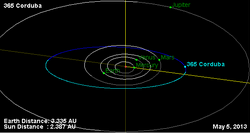Astronomy:365 Corduba
From HandWiki
Short description: Very large asteroid in the main belt of asteroids
 Orbital diagram | |
| Discovery | |
|---|---|
| Discovered by | Auguste Charlois |
| Discovery date | 21 March 1893 |
| Designations | |
| (365) Corduba | |
| Pronunciation | /ˈkɔːrdjʊbə/[2][3] |
| Named after | Possibly Córdoba, Spain[1] |
| 1893 V | |
| Minor planet category | Main belt |
| Orbital characteristics[4] | |
| Epoch 31 July 2016 (JD 2457600.5) | |
| Uncertainty parameter 0 | |
| Observation arc | 117.96 yr (43084 d) |
| |{{{apsis}}}|helion}} | 3.2417 astronomical unit|AU (484.95 Gm) |
| |{{{apsis}}}|helion}} | 2.36078 AU (353.168 Gm) |
| 2.80122 AU (419.057 Gm) | |
| Eccentricity | 0.15723 |
| Orbital period | 4.69 yr (1712.5 d) |
| Mean anomaly | 233.78° |
| Mean motion | 0° 12m 36.792s / day |
| Inclination | 12.792° |
| Longitude of ascending node | 185.196° |
| 216.45° | |
| Physical characteristics | |
| Dimensions | 105.92±3.0 km[4] 104.51 ± 2.42 km[5] |
| Mass | (5.84 ± 0.95) × 1018 kg[5] |
| Mean density | 9.76 ± 1.73 g/cm3[5] |
| Rotation period | 12.705 h (0.5294 d) |
| Geometric albedo | 0.0335±0.002 |
| C | |
| Absolute magnitude (H) | 9.2 |
Corduba (minor planet designation: 365 Corduba) is a very large main-belt asteroid that was discovered by the French astronomer Auguste Charlois on 21 March 1893 from Nice. It is classified as a C-type asteroid and is probably composed of carbonaceous material.
Photometric observations of this asteroid at the Palmer Divide Observatory in Colorado Springs, Colorado, during 2007 gave a light curve with a period of 6.551 ± 0.002 hours and a brightness variation of 0.05 in magnitude. This differs somewhat from a 2004 study that gave a period of 6.354 hours, but this difference may be explained by the small magnitude variation which tends to increase the randomizing effect of noise in the data.[6]
References
- ↑ Schmadel, L. (2003:45). Dictionary of minor planet names. Germany: Springer.
- ↑ Walker (1830) A Key to the Classical Pronunciation of Greek, Latin, and Scripture Proper Names
- ↑ Noah Webster (1884) A Practical Dictionary of the English Language
- ↑ 4.0 4.1 Yeomans, Donald K., "365 Corduba", JPL Small-Body Database Browser (NASA Jet Propulsion Laboratory), https://ssd.jpl.nasa.gov/sbdb.cgi?sstr=365, retrieved 11 May 2016.
- ↑ 5.0 5.1 5.2 Carry, B. (December 2012), "Density of asteroids", Planetary and Space Science 73: pp. 98–118, doi:10.1016/j.pss.2012.03.009, Bibcode: 2012P&SS...73...98C. See Table 1.
- ↑ Warner, Brian D. (June 2008), "Asteroid Lightcurve Analysis at the Palmer Divide Observatory - June - October 2007", The Minor Planet Bulletin 35 (2): pp. 56–60, Bibcode: 2008MPBu...35...56W.
External links
- Lightcurve plot of 365 Corduba, Palmer Divide Observatory, B. D. Warner (2007)
- Asteroid Lightcurve Database (LCDB), query form (info )
- Dictionary of Minor Planet Names, Google books
- Asteroids and comets rotation curves, CdR – Observatoire de Genève, Raoul Behrend
- Discovery Circumstances: Numbered Minor Planets (1)-(5000) – Minor Planet Center
- 365 Corduba at AstDyS-2, Asteroids—Dynamic Site
- 365 Corduba at the JPL Small-Body Database
 |

